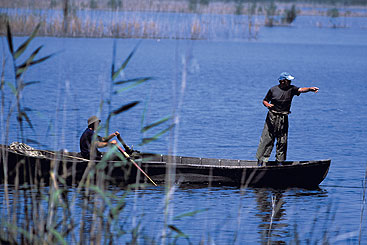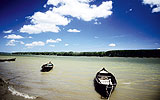The Danube Strategy: uniting policies under the roof of the river basin
The European Union’s new Strategy for the
Danube brings together policies and structures
to provide new opportunities for sustainable
development in the region.

The Danube Strategy:
uniting policies under the roof of the river basin
The European Union’s new Strategy for the Danube brings together policies and structures to provide new opportunities for sustainable development in the region.

The Danube Strategy emphasises the need for an integrative approach to development, and mentions the ICPDR and its work at several points, especially in the chapter on environmental protection.
The eu strategy for the danube Region, adopted by the european Commission this december 2010, will encompass political, social, cultural, environmental and economic issues, while balancing concerns for the environment, energy and climate policy, food and water safety and environmentally friendly navigation.

ICPDR Executive Secretary Philip Weller speaks about the challenge and opportunity the Strategy will bring for all Danube countries.
How was the ICPDR involved in the drafting of the Danube Strategy?
“The Danube Strategy is a document drafted by the Commission for the Member States of the European Union. As such, the document itself is a product of officials of the Union. The ICPDR President, the Secretariat and in particular the contracting parties to the Convention, both EU and non-EU, have nonetheless had significant input into the development of the Strategy. The Commission sought input from all relevant actors in the preparation of the Strategy (Member States, non-EU countries and NGOs). The ICPDR as one of the few institutions which is organised around the geographic territory of focus for the Danube Strategy was therefore strongly involved. The contracting parties of the ICPDR also strongly emphasised the need for the existing products of the ICPDR such as the River Basin Management Plan to be acknowledged and supported by the Strategy. The ICPDR has a mandate from the countries that make up the region to address one of the central pillars of activity of the Danube Strategy: the protection of water resources. It also has existing products and actions that should be reinforced in the Strategy.”
Looking at the EU Strategy for the Baltic Sea, critical voices have pointed out that no additional money will be spent on the Danube Strategy and that no one should expect too much.
“It is true that the three ‘NOs’ – no new legal framework, no new institutions and no new financing – have been clearly stated by the European Commission. It is my strong belief, however, that certainly in the area of water management the use of existing funds can be much better focused and directed at the most important issues. Key successes can be achieved without additional funding. In particular, it is clear that simple solutions such as a limitation on phosphates in detergents do not cost a lot of money but can have significant consequences. One of the central issues connected with water management is that it is necessary that water management actions need to be built into the actions of other sectors. The use of existing funding mechanisms (CAP funding, infrastructure funds, and other funding) to address issues in those sectors but accounting for environmental considerations is possible. The existing and future funds for the non-EU Member States can also be directed at critical issues related to water management.
“The ICPDR has also recognised that plans and governmental action alone will not ensure environmental protection. The efforts to improve water quality and reduce flood risk within the framework of the ICPDR have been reinforced by successful awareness-raising activities for citizens of the basin including the yearly celebration of Danube Day on June 29, and the creation of the Danube Box, an education kit for teachers prepared together with corporate supporters. This has both demonstrated the possibilities of cooperation with business in supporting the goals of an improved environment and engaged thousands of students in learning about ‘their Danube’. These products and activities of the ICPDR can be built upon and strengthened in the development and implementation of the Strategy.”

The measures related to the Danube Strategy will largely follow the ICPDR’s Danube River Basin Management Plan of 2009.
The Danube Strategy emphasises the importance of intersectoral collaboration. How should the ICPDR contribute to such collaboration?
“Intersectoral cooperation is essential for achieving successful development in the Danube region. One of the three pillars of the Danube Strategy, currently under preparation by the European Commission, is environment. Although specific environmental initiatives in the Strategy are needed, environmental considerations must be built into all aspects of development if sustainability is to be achieved. An active process of cooperation between authorities responsible for agriculture and environment is to be supported to ensure that measures against agricultural pollution are put in place: manure storage facilities, buffer strips, fertilizer and pesticide application limits, for example. In particular a workshop involving both agricultural and water ministries is needed on the relevant instruments of the EU Common Agricultural Policy and Best Agricultural Practices for ensuring reduction of agricultural pollution.
“For the water sector in particular it is necessary that there be cooperation and coordination with the agriculture, energy and transportation sectors. If the actions and activities of these sectors are organised in a way that water is held in a good condition, then it is not necessary to make huge investments in improving water quality or flood protection.”
The Danube Strategy
The EU Strategy for the Danube Region was adopted by the European Commission on 8 December 2010. It is a comprehensive set of policies under a common roof – that of the Danube region. Formally, the strategy comprises a Communication and an Action Plan. Its implementation will start following the official endorsement by the EU Member States through the EU Council under the current Hungarian Presidency in April.
Six key areas of the Danube Strategy are:
• mobility
• risks
• energy
• socio-economic development
• environment
• security
Since many of these areas are interlinked, the strategy emphasises the need for an integrative approach to them at several points.
For the ICPDR, the environment, mobility and risks (particularly floods) are the most relevant areas. The action plan of the Danube Strategy mentions the ICPDR and its work at several points, especially in the chapter on environmental protection, which is divided into three priority areas: (1) restoration and maintenance of water quality; (2) management of environmental risks; and (3) preservation of biodiversity, landscapes and the quality of air and soil. The corresponding measures largely follow the ICPDR’s Danube River Basin Management Plan of 2009 and related activities.
In addition, the Joint Statement on inland navigation, the Platina Manual on sustainable waterway planning and the WANDA project to improve waste management are highlighted in the navigation part.
The strategy follows past examples, most importantly the EU Strategy for the Baltic Sea. Similar to this, the Danube Strategy relies on existing policies and structures – no new EU funds, legislation or structures will be created.
For more information about the Danube Strategy, please visit: http://www.danube-region.eu





